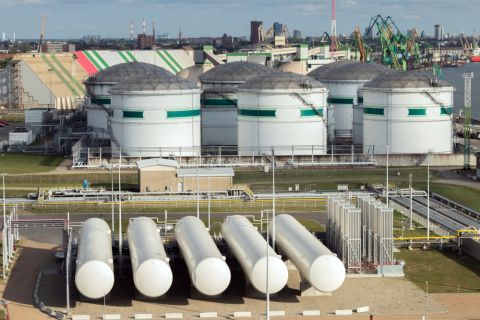 |
| Sun reflects off a battery of steam generators at Jackfish, a steam-assisted gravity drainage (SAGD) project in Alberta's oil-sands region. |
Canada’s oil-sands producers have been hit with dizzying drops in commodity prices and spinning credit markets, and they have reacted swiftly. Suncor Energy has delayed construction of an oil-sands upgrader for its Voyageur expansion by a year; Petro-Canada is considering a delay on its Fort Hills upgrader; Nexen Inc. and Opti Canada have put off a decision on the second phase of their Long Lake project until sometime in 2009; and construction of the Heartland upgrader near Edmonton has been halted by Value Creation Group.
Related story: ‘Perception’ Among Obstacles Facing Oil-Sands Projects
Yet, operators of in-situ projects are standing pat, largely because their ventures don’t require vast bankrolls. More akin to conventional oil production, in-situ projects can be implemented in stages, in sequential antes drawn from cash flow. Furthermore, as oil prices fall, so do costs for natural gas and diluent, two of the major raw materials spent in in-situ operations.
Devon Energy Corp., the only U.S.-based independent with a major stake in Canada’s oil sands, remains all-in at its Jackfish and Jackfish 2 steam-assisted gravity drainage (SAGD) projects. These lie some 140 kilometers south of Fort McMurray in Alberta’s boreal forest.
The Oklahoma City-based company has 100% working interest in each 300-million-barrel project. Jackfish was built for C$730 million, and steam injection started in August 2007. It currently produces 14,500 barrels of bitumen a day; its full production rate of 35,000 barrels a day will be achieved in the first half of 2009.
And, Devon recently received approval for Jackfish 2, a similar-scale project 10 kilometers west of Jackfish, and it is now clearing the site. Costs for Jackfish 2 are estimated at C$1 billion, due to inflation in labor and material costs, but the recoverable bitumen and target production rates are the same as the initial venture.
“Jackfish 2 will be a clone of Jackfish,” says Chris Seasons, Calgary-based president of Devon Canada Corp. “We’re using the same design, and applying the learnings from Jackfish to that project.”
Environmental strategies
Oil-sands developments have suffered in recent times from a poor public image. Some believe that the impact of their extraction and use is too severe when compared with benefits.
 |
| Canada's oil sands are estimated to hold 1.7 trillion barrels of in-place bitumen, and about 10% is classed as recoverable reserves. |
Truly, Canada’s immense resource offers both incredible promise and a daunting challenge. The 1.7-trillion-barrel Athabasca bitumen deposit, of which 173 billion barrels are recoverable, covers an area the size of Florida. It is the largest treasure of oil sands in the world.
At present, some 1.32 million barrels a day of bitumen are coaxed from northeastern Alberta’s oil sands. Mines contribute 65% of that total, and in-situ projects—mainly SAGD—account for the remainder. Some 20% of Canada’s resource is amenable to mining; in-situ methods will extract the rest, so production will shift toward the latter in years to come.
Of course, mining oil sands is an obvious assault on the surface. SAGD projects have tiny footprints in comparison—Jackfish occupies a 400-by-800-meter site. At full lease development, Jackfish will disturb less than 5% of the surface to produce its entire 300-million-barrel resource.
Still, such projects have not escaped environmental scrutiny. Two major concerns swirl around SAGD: the source and disposition of the huge volumes of water needed to produce steam, and emissions of greenhouse gases from natural gas burned to fuel steam generators.
Water use is indeed formidable. SAGD projects process literally tons of water, and feature impressive arrays of water-handling facilities. Typically, 2.5 to three barrels of steam (measured in cold-water barrels) are needed to produce a barrel of bitumen.
In a pioneering development, Devon’s Jackfish is the first oil-sands project to use only saline water for its steam generation. The company processes some 100,000 barrels of water per day, and recycles nearly 95% of that.
“The only fresh water we use on site is for potable drinking water,” says Seasons. “It’s more costly to use saline water, but it’s a commitment we made from the outset.”
The company has a water-source well in the Grand Rapids C zone, a formation found above the McMurray bitumen reservoir. Devon produces saline water (with total dissolved solids content of 6,000 to 8,000 parts per million), treats it to remove salts and solids, and converts the clean water to steam. In an ongoing cycle, the steam is injected, and then produced along with bitumen, separated and treated for use again. The process is so efficient that make-up water is less than 5,000 barrels a day.
This spring, the Canadian Association of Petroleum Producers recognized Devon’s efforts with a stewardship award for its saline water use at Jackfish.
Reducing emissions
Another feature of Jackfish that delivers environmental benefit is its emphasis on heat integration. SAGD projects typically burn 1,000 cubic feet of gas to make three barrels of steam. At Jackfish, the design steam-to-oil ratio is 2.65, so gas use is roughly equivalent to 1,000 cubic feet per 1.2 barrels of produced bitumen. Devon works to wring the most energy it can from every cubic foot of that gas.
“We circulate reservoir fluids through the plant, to optimize extraction of heat,” says Will Yakymyshyn, vice president, thermal heavy oil. That means Devon can burn less natural gas; in the course of Jackfish’s 20-year life, heat-integration efforts will prevent 1.8 billion metric tons of CO2 emissions.
The company is also working on broad industry initiatives to reduce greenhouse-gas emissions. “Since 1990, the industry as a whole has reduced CO2 intensity—emissions per barrel produced—from oil sands by 45%,” he says.
“That’s not absolute reduction, which is the ultimate goal, because Canada’s bitumen production has been growing so rapidly.”
Currently, Alberta’s oil-sands producers are evaluating recent provincial regulations and new federal guidelines that call for reductions in greenhouse-gas emissions. “As soon as the different guidelines and regulations are harmonized, we can assess our operating framework going forward.”
In that light, Devon is a member of a number of industry groups and consortia that are addressing technology development for carbon capture and storage. “We don’t yet have cost-effective solutions, but we all are actively working on the problem.”
Dynamic process
At Jackfish, the McMurray formation lies 415 to 450 meters below the surface. Devon drills laterals that reach horizontally 800 to 900 meters within a 40-meter pay interval. Laterals are stacked directly on top of one another, five meters apart. Well pairs are drilled seven to a pad; there are a total of 25 well pairs currently producing. Each well pair costs C$10 million, has a projected life of seven years, and will recover 50% of the original in-place oil.
To date, performance at Jackfish compares very favorably to other SAGD projects. When fully charged with steam, producing well pairs each make on average 1,200 to 1,500 barrels per day.
SAGD projects are not assembly-line operations; conditions are dynamic and well pairs have to be continually managed. “We are constantly trying to maximize recovery of reserves,” says Yakymyshyn. Reservoir pressures, temperatures and chemistries have to be closely watched and adjusted.
Jackfish is a high-pressure project. Because Devon has bottom water below its pay interval, it keeps its steam pressures in balance with pressures in the lower zone. That means Jackfish wells produce with gas lift, due to their reservoir pressures.
“When Devon made the commitment to oil sands, we focused on geology first,” he says. “It’s all about the reservoir, and producing bitumen efficiently.”
Another enhancement: Devon designed Jackfish so it could mix either synthetic oil or condensate with its bitumen to bring it to pipeline specifications.
The company, along with its 50% partner, Calgary-based MEG Energy, built Access Pipeline. The 340-kilometer line runs from north of Jackfish to a 350,000-barrel tank farm near Edmonton. From there, the product can go anywhere in North America. It features a 24-inch blend line and a 16-inch diluent line.
“We have the ability to run either; currently we’re running a dilbit product,” says Seasons. Devon’s dilbit is bitumen mixed with condensate; it can also run synbit, bitumen diluted with synthetic oil. “The set-up gives us good flexibility.”
Truly, that’s the story of SAGD. It’s a scalable technology that can be implemented in modules, and it can be adapted to operate successfully under a variety of conditions.
“Oil sands are attractive to Devon, and to industry in general, because they are quality resources in an accessible area with a good fiscal regime and stable political environment,” says Seasons.
“Their high production volumes, sustainable for 20 years, provide attractive platforms for company growth.”
It’s a game that Devon is willing to play, and it’s already holding a strong hand.
Recommended Reading
Diamondback’s Van’t Hof Plays Coy on Potential Delaware Divestiture
2024-05-16 - Diamondback Energy’s President and CFO Kaes Van't Hof also addressed new Permian exploration and the lack of “fun” dealing with the FTC on its deal to buy Endeavor Energy Resources.
Minerals Market Growing But Needs More Scale, Consolidation
2024-05-15 - The market value of public minerals and royalties companies has doubled since 2019—but the sector needs to grow even larger to attract generalist investors into the fray, experts say.
Marketed: Berlin Resources Anadarko Basin Opportunity
2024-05-13 - Berlin Resources LLC has retained EnergyNet for the sale of an Anadarko Basin opportunity in the Donita 35/2 AP #1H in Roger Mills County, Oklahoma.
TotalEnergies, Sinopec to Develop SAF Unit in China
2024-03-26 - TotalEnergies and Sinopec’s production unit will have the capacity to produce 230,000 tons of sustainable aviation fuel per year.
‘Unexpected’ JV to Move Permian NatGas to Gulf Coast LNG Terminals
2024-03-26 - A trio of midstream companies—Enbridge, Whitewater and MPLX—will work together to build infrastructure to transport Permian Basin natural gas to Gulf Coast LNG terminals.




